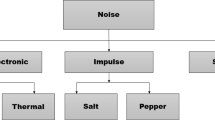Abstract
In the presence of metallic implants in the human body, metallic artefacts are introduced into X-ray CT images. Metallic artefacts frequently lead to heavy artefacts which can obscure important information and could seriously degrade the quality of the CT image, therefore, influence the clinician’s diagnostic results. Many methods have been developed in recent years where the problem of reducing the metallic artifact has been widely studied, providing a number of solutions. In this work, we propose a new, fast and efficient method to remove artifacts. The proposed method consists in using the image reconstructed from a sinogram affected by the artefacts in order to generate a synthesized sinogram instead of the originally measured sinogram. The main steps are: the segmentation method, the method of filling gaps in the sinogram and improving the image respectively. We used a fast segmentation method based on the K-means classification. For the recovery of the lost data, we proposed the adaptation of a method based on the discrete cosine transform (DCT). Finally for the reconstructed image enhancement we used an improved contrast equalization technique in order to restore the image intensities to their natural dynamic range. The proposed method has been verified for simulations on a Shepp–Logan phantom as well as on clinical data. This method offers a remarkable improvement in image quality







Similar content being viewed by others
REFERENCES
Usman Ghani, M. and Clem Karl, W., Fast enhanced CT metal artifact reduction using data domain deep learning, IEEE Trans. Comput. Imaging, 2020, vol. 6.
Frederique, L., Identification et réduction de l’artefact métallique en tomographie à rayons X, Thesis, Talence, 2017. https://tel.archives-ouvertes.fr/tel-01537663.
Müller, J. and Buzug, T.M., Spurious structures created by interpolation-based CT metal artifact reduction, Med. Imaging 2009: Phys. Med. Imaging (Orlando, 2009), article ID 725816. https://doi.org/10.1117/12.813515.
Zhang, Y. and Yu, H., Convolutional neural network based metal artifact reduction in Xray computed tomography, IEEE Trans. Med. Imaging, 2018. https://doi.org/10.1109/tmi.2018.2823083
Park, H.S., Hwang, D., and Seo, J.K., Metal artifact reduction for polychromatic X-ray CT based on a beam-hardening corrector, IEEE Trans. Med. Imaging, 2016, vol. 35, no. 2.
Zhang, Y., Pu, Y.-F., Hu, J.-R., Liu, Y., and Zhou, J.-L., A new CT metal artifacts reduction algorithm based on fractional-order sinogram inpainting, J. X-ray Sci. Technol., 2011, vol. 19, no. 3, pp. 373–384.
Mehranian, A., Ay, M.R., Rahmim, A., and Zaidi, H., X-ray CT metal artifact reduction using wavelet domain L0 sparse regularization, IEEE Trans. Med. Imaging, 2013, vol. 32, no. 9, pp. 1707–1722.
Zhang, Y., Mou, X., and Yan, H., Weighted total variation constrained reconstruction for reduction of metal artifact in CT, IEEE Nucl. Sci. Symp. Med. Imaging Conf. (2010 NSS/MIC) (Knoxville, 2010), pp. 2630–2634.
Lemmens, C., Faul, D., and Nuyts, J., Suppression of metal artifacts in CT using a reconstruction procedure that combines map and projection completion, IEEE Trans. Med. Imaging, 2009, vol. 28, no. 2, pp. 250–260.
Chang, Z., Ye, D.H., Srivastava, S., Thibault, J. B., Sauer, K., and Bouman, C., Prior-guided metal artifact reduction for iterative X-Ray computed tomography, IEEE Trans. Med. Imaging, 2019, vol. 38, no. 6.
Arabi, H. and Zaidi, H., Deep learning–based metal artefact reduction in PET/CT imaging, Eur. Radiol., 2021. https://doi.org/10.1007/s00330-021-07709-z
Amorim, R.C. and Makarenkov, V., Applying subclustering and Lp distance in weighted K-means with distributed centroids, Neurocomputing, 2016, vol. 173, pp. 700–707.
Lin, C.-H., Chen, C. C., Lee, H. L., and Liao, J. R., Fast K-means algorithm based on a level histogram for image retrieval, Expert Syst. Appl., 2014, vol. 41(7), pp. 3276–3283.
Wang, G., Garcia, D., Liu, Y., Richard de Jeu, C.D., and Johannes Dolman, A., A three-dimensional gap filling method for large geophysical datasets: Application to global satellite soil moisture observations, Environ. Model. Software, 2012, vol. 30, pp. 139–142.
Garcia, D., Robust smoothing of gridded data in one and higher dimensions with missing values, Comput. Stat. Data Anal., 2010, vol. 1, no. 54(4), pp. 1167–1178. https://doi.org/10.1016/j.csda.2009.09.020.
Allag, A., Benammar, A., Drai, R. and Boutkedjirt, T., Tomographic Image reconstruction in the case of limited, number of X-ray projections using sinogram inpainting, Russ. J. Nondestr. Test., 2019, vol. 55, no. 7, pp. 542–548.
Tan, X. and Triggs, B., Enhanced local texture feature sets for face recognition under difficult lighting conditions, IEEE Trans. Image Process., 2010, vol. 19(6), pp. 1635–1650.
Al-Ameen, Z., An improved contrast equalization technique for contrast enhancement in scanning electron microscopy images, Wiley Periodicals: Microsc. Res. Tech., 2018, pp. 1–11, 2018. https://doi.org/10.1002/jemt.23100
Zhao, S., Robertson, D.D., Wang, G., Whiting, B., and Bae, K.T., X-ray CT metal artifact reduction using wavelets: an application for imaging total hip prostheses, IEEE Trans. Med. Imaging, 2000, vol. 19, no. 12, pp. 1238—1247.
Author information
Authors and Affiliations
Corresponding author
Rights and permissions
About this article
Cite this article
Benammar, A., Allag, A., Araar, I. et al. Fast Method to Reconstruct and Enhance CT Images: Applied to Metal Artifact Reduction. Russ J Nondestruct Test 57, 600–608 (2021). https://doi.org/10.1134/S1061830921070032
Received:
Revised:
Accepted:
Published:
Issue Date:
DOI: https://doi.org/10.1134/S1061830921070032




